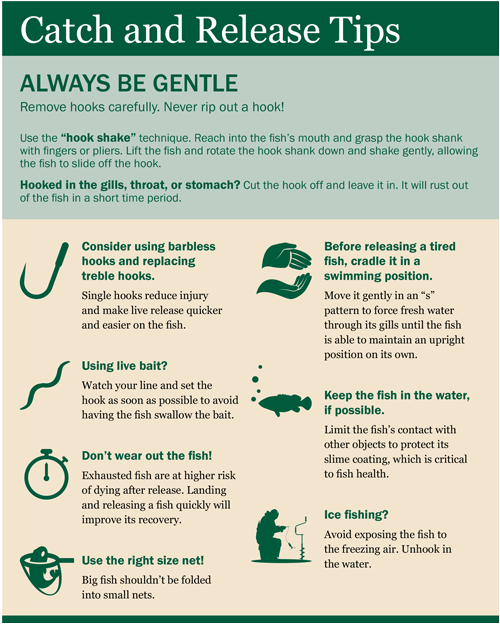
Catch and release fishing is another great way for anglers to achieve a rewarding fishing experience.
 If you’d rather release your catch instead of harvesting it, there are some important steps you should follow. Following these steps will help ensure the fish will survive to be caught another day.
If you’d rather release your catch instead of harvesting it, there are some important steps you should follow. Following these steps will help ensure the fish will survive to be caught another day.
-
Land a fish as quickly as possible. Fish played gently for too long may be too exhausted to recover.
-
Keep the fish in the water as much as possible while unhooking it, and gently restrain it to minimize violent thrashing.
-
Never rip the hook out of a fish. Use the” hook shake” method to gently remove hooks. Reach into the fish’s mouth and grasp the hook shank with fingers or pliers. Lift the fish and rotate the hook shank down and shake gently, allowing the fish to slide off the hook.
-
Using barbless hooks increases fish survival, particularly when fishing with bait. Pinch barbs flat with pliers.
-
When a fish that is hooked in the gills, throat or stomach cut the line close to the hook and leave the hook in the fish. The hook will rust off the fish within a few months.
-
Reduce the chance of fish swallowing bait when fishing with live bait by continuously watching the line and setting the hook as soon as possible.
-
When ice fishing, keep the fish in the water while unhooking it to avoid exposing it to the freezing air. This will prevent the fish’s eyes and gills from freezing.
-
Before releasing an exhausted fish, cradle it in a swimming position and move it gently back and forth to force fresh water through its gills Continue this movement until the fish is able to maintain an upright position on its own. This could take up to 10 minutes for large, exhausted fish.
